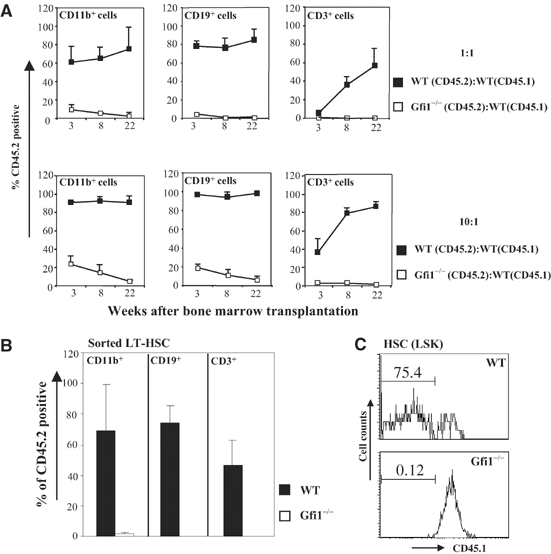Figure 5.

Gfi1-deficient HSCs are defective in their reconstituting ability. (A) Competitive repopulation assay with WT and Gfi1−/− bone marrow cells. In all, 2 × 105 WT or Gfi1−/− bone marrow cells (CD45.2+) were mixed with the same number of competitor CD45.1+ bone marrow cells and were injected into lethally irradiated CD45.1+ mice (n=4). Peripheral blood was analyzed at various times after reconstitution for the presence of WT or Gfi1−/− bone marrow (CD45.2+)-derived myeloid, B-lymphoid and T-lymphoid cells (upper panels marked 1:1). The same experiments were performed using 2 × 106 WT or Gfi1−/− bone marrow cells (CD45.2+) mixed with 2 × 105 competitor CD45.1+ bone marrow cells (n=4, lower panels marked 10:1). (B) A total of 500 sorted WT or Gfi1−/− LT-HSCs (CD45.2+) were mixed with 2 × 105 competitor CD45.1+ bone marrow cells and injected into lethally irradiated CD 45.1+ mice (n=4). Peripheral blood was analyzed 22 weeks after reconstitution for the presence of WT or Gfi1−/− LT-HSC-derived myeloid (CD11b+), B-lymphoid (CD19+) and T-lymphoid cells (CD3+). (C) At 6 months after reconstitution, bone marrow cells from mice described in (B) were analyzed to measure the percentage of LSK cells derived from transplanted WT or Gfi1−/− LT-HSCs. Representative diagrams show the contribution of donor-derived HSCs (CD45.1− LSK) in WT and Gfi1−/− LT-HSCs transplanted recipients (75.4 or 0.12%, respectively).
